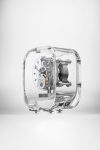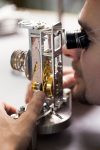Jaeger-LeCoultre
A QUIET REVOLUTION
Jaeger-LeCoultre
A QUIET REVOLUTION
It is the intersection of invisible elements in the Atmos that so beguiles us; that easily understood concepts like temperature and pressure could be linked together in such a startling way to produce a machine that runs forever.
How does the clock work? Simple.
The key is a capsule filled with ethyl chloride gas, notable for its property of responding to changes in temperature with relatively large changes in volume. This is what enables the expansion and contraction of the capsule, a motion whose energy is transferred to a chain that moves back and forth, winding the mainspring in the process.
From here on, the power gathered by the mainspring is used to run the clock movement — one made as finely and as precisely as humanly possible to minimize friction and loss of power. In fact, the clock is so efficient that only a one-degree change of temperature is enough to run it for two whole days.
The Atmos clock is a beautiful manifestation of that eternal dream of a perpetual motion machine, and within the parameters of our environment, is as close as one can get. Indeed, as long as the sun rises and sets every day, the temperature variations will (barring servicing of the components) run the clock forever.
If you like intricately made watches, then you’ll like the Atmos, a mechanical beauty made with the same level of care and craftsmanship.
Yet for all the wonders that this clock is capable of, it is sometimes easy to forget what it represents as a technical achievement. Part of this is in the way it works — quietly, efficiently and without fuss. And while it is nice to house this mechanism in a cabinet that is more classically designed, in the vein of normal clocks of old, it is when all of its insides are revealed that the Atmos truly comes into its own, as an object that symbolizes the incredible fusion of art and science.
The simplest way to describe the shape of the Baccarat crystals housing the movements of the two clocks would be to imagine them as clear square crystal bubbles that offer a stupendous view of the sophisticated movement within. The Atmos 561, the first collaboration with Newson, was designed to commemorate the 80th anniversary of Jaeger-LeCoultre’s first Atmos clock. The Atmos 566 that came five years later was Newson’s reinterpretation of the Atmos Astronomique, with a movement that included a sky chart depicting the Northern hemisphere, along with the cardinal points and zodiac signs, but this time housed in a blue Baccarat crystal.
The main idea with the Atmos 568 is that it has an even greater feeling of transparency and lightness, with many elements refined to achieve this effect. Gone are the visible boarders of the transparent disc holding the hour markers, and from the front, the counterweight that forms the winding mechanism is even more integrated into the visible elements such that it seems to disappear into thin air. As with the previous two clocks, the four-point bridge that Newson introduced for symmetry is retained, but the flourish of the attachment points, made obvious when mirrored by the curvature of the crystal case, has been removed, making the bridge appear more elegant, and more purposeful.
More obviously as well, when the new Atmos 568 is placed side by side with the previous creations, one sees that the shape of the housing is different, less of a square bubble now, but taller and with a pronounced base, much like the look of a vintage television or even a classic iMac.
The Atmos 568 is an impressive continuation of the grand maison’s remarkable collaboration with one of the world’s most acclaimed designers, and one sees in this an evolution towards a purer rendition of form for the Atmos. For a clock that works via invisible forces in the air, the Atmos 568 comes the closest to exemplifying the ethereal and delicate qualities of its power source.



















